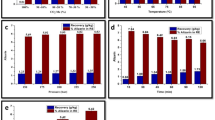Abstract
The possibility of improving an existing method, based on supercritical-fluid extraction (SFE) and microwave-assisted extraction (MAE), for the determination of banned azo dyes in leather has been studied. Thus, optimization of experimental conditions in different steps (degreasing, reduction, and extraction) of the analytical procedure was performed. The influence of different variables (reaction time, temperature, and concentration of reducing agent) on the reduction process was evaluated by use of a factorial design. It was found that the concentration of the reducing agent and the interaction between time and temperature were the most influential variables. Consequently, by applying a higher temperature, the reaction time could be halved. The use of acidified water as extraction solvent in MAE was also investigated. Usually 1 mol L−1 HCl was superior to methanol and buffer in terms of extraction efficiency. In conclusion, the present method gave significantly higher recoveries in comparison with the original method. All dyes were determined indirectly by measuring their corresponding harmful amines, formed after reduction by use of sodium dithionite.



Similar content being viewed by others
References
Hildenbrand S, Schmahl FW, Wodarz R, Kimmel R, Dartsch PC (1999) Int Arch Occup Environ Health 72:M52
Platzek T, Lang C, Grohmann G, Gi US, Baltes W (1999) Hum Exp Toxicol 18:552
Chung KT (2000) Environ Carcino Ecotox Rev C18:51
Benigni R, Passerini L (2002) Mutat Res 511:191
European Commission (2002) Off J Eur Commun L 243:15
Second Amendment to the German Consumer Goods Ordinance (1994) Bundesgesetzblatt Part 1:1670
Pindar AG, Tinsley HM (1984) Analyst 109:1101
Puntener A, Mausezahl D, Page C (1993) J Soc Leather Technol Chem 77:1
Straub RF, Voyksner RD, Keever JT (1993) Anal Chem 65:2131
Voyksner RD, Rolf S, Keever JT, Freeman HS, Hsu WN (1993) Environ Sci Technol 27:1665
Muralidharan D, Sundara Rao VS (1994) J Soc Leather Technol Chem 78:139
Planelles F, Verdu E, Campello D, Grane N, Santiago JM (1998) J Soc Leather Technol Chem 82:45
Garrigós MC, Reche F, Marín ML, Jiménez A (2002) J Chromatogr A 976:309
Friedrichs K, Winkeler HD, Prior G (1995) GIT Fachz Lab 39:901
Winkeler HD (1996) GIT Spezial–Chromatographie 16:6
Cioni F, Bartolucci G, Pieraccini G, Meloni S, Moneti G (1999) Rapid Commun Mass Spectrom 13:1833
Plum A, Engewald W, Rehorek A (2003) Chromatographia 57:S243
DIN 53316 (1997) DIN Deutsches Institut für Normung e.V
Höner A, Schulz H, Henriks-Eckerman M-L, Mathiasson L, Wegener JW, Winkeler HD (2000) Final report, development of a harmonized test method for the detection of certain aromatic amines in leather due to the use of azo dyes, European Commission
European Commission, AALARM project G6RD-CT-2001-00600620, http://www.euroleather.com/aalarm.htm
Eskilsson CS, Davidsson R, Mathiasson L (2002) J Chromatogr A 955:215
Acknowledgments
The authors would like to thank Dr Haiko Schulz at the Research Center for Leather and Artificial Leather (FILK, Freiberg, and Germany) for providing the leather samples. The EC is acknowledged for financial support (project No. G6RD-CT-2001-00600620).
Author information
Authors and Affiliations
Corresponding author
Rights and permissions
About this article
Cite this article
Ahlström, LH., Björklund, E. & Mathiasson, L. Optimization of an analytical procedure for the determination of banned azo dyes in leather. Anal Bioanal Chem 382, 1320–1327 (2005). https://doi.org/10.1007/s00216-005-3240-2
Received:
Revised:
Accepted:
Published:
Issue Date:
DOI: https://doi.org/10.1007/s00216-005-3240-2




